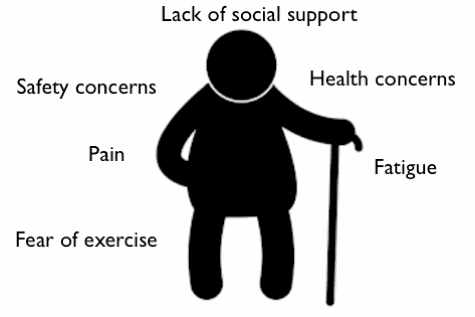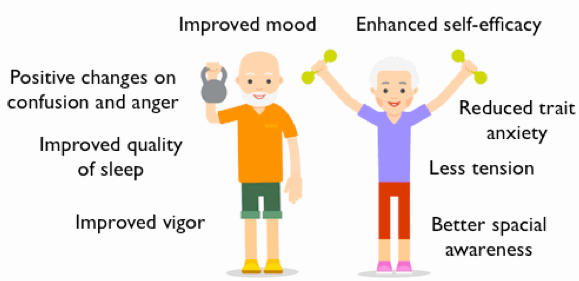| Resistance Training for Older Adults: New NSCA Position Stand Len Kravitz, Ph.D. Article Reviewed Fragala, M.S., Cadore, E. L., Dorgo, S. et al. (2019). Resistance training for older adults: Position statement from the National Strength and Conditioning Association. 33(8), 2019-2052. Introduction Fitness pros are quite aware that maintaining and/or increasing muscle strength and mass, from resistance exercise, is pivotal for helping to thwart off the hampering outcomes of a sedentary lifestyle, particularly as a person ages. Addressing this issue, the National Strength and Conditioning Association recently published the organization's first position statement (with 663 research citations) on the recommendations for resistance training for older adults (persons 65 years of age and older). Muscle mass and strength interventions with older adults focus on minimizing the deleterious effects on immobility, chronic disease management, physical functioning, psychological well-being and quality of life. Highlights from this new statement bring to light compelling evidence that resistance training should be a life-long activity for all. What are the evidence-based resistance training guidelines for older adults? For healthy older adults, resistance training with proper instruction and spotting (when needed) of exercises performed with correct technique is healthy and safe. Program designs should follow an individualized, periodized progression striving to complete 2-3 sets per major muscle group with 2 minutes rest between sets (Fragala et al., 2019). Exercise selection may include 8-10 exercises including shoulder press, chest press, latissimus dorsi pull-down, biceps curl, triceps extension, lower back extension, abdominal crunches, leg press (or quadriceps extension), leg curls and heel raises. For entry-level older persons, the research indicates no physiological outcome difference in single versus multiple sets, so starting with single set training is quite applicable. Load should progress from low (<51% of 1 repetition maximum [1RM]), to moderate (51-69% of 1RM) and eventually, for some older clients, to high (70-85% 1RM) intensities on 2-3 days per week (Fragala). Importantly, Fragala summarize that training repetitions to failure has NOT been shown to promote any additional physiological adaptation with older persons. In fact, for many older clients training in the 50-70% of 1RM with excellent exercise form may be a more than satisfactory (and safe) muscular training stimulus: thus the importance of individualization of the training program. With repetitions, the researchers summarize 10-15 repetitions is suitable for beginners and 6-12 repetitions with variation is suitable for muscular strength in healthy older persons. The incorporation of power exercises, performed at 40-60% of 1RM is also encouraged in the older person resistance training program design. This type of training involves performing the concentric action explosively up to maximal exertion. Fragala et al. (2019) highlight that this power component to exercise performance has been shown to promote greater functional improvement of activities of daily living. What are the resistance training guidelines for adults with frailty? Fragala et al. (2019) explain that frailty is an age-related syndrome typifying decreases in biological function and resistance to stressors, due to changes in several physiological systems. Frailty is the main risk factor for disability in aging men and women. Resistance training in this population may help restore physical function. Recommendations include doing resistance training 3 sessions per week, working up to 3 sets of 8-12 repetitions. Load should start at 20-30% 1RM and may increase over time to 80% 1RM. Incorporate power exercises performed at 30-60% of 1RM. Functional exercises that simulate activities of daily living (i.e., sit-to-stand) will also enhance functional capacity. What are the deleterious effects associated with loss in muscle strength and mass? Fragala et al. (2019) summarize that the gradual loss of muscle mass (in sedentary persons) will generally begin at age 30 and then accelerate to 10% in adults older than 60. This loss of muscle mass continues to increase to greater than 50% in adults over 80 years. A simultaneous loss of muscular strength is highly associated to physical disability, type 2 diabetes, cognitive decline, osteoporosis, and mortality. Alarmingly, the researchers cite evidence that persons who are inactive have been found to have double the risk of future mobility limitations as compared to those who meet the U.S. Surgeon General's recommendation for physical activity (at least 150 minutes of moderate intensity physical activity per week). How does resistance exercise counteract the negative consequences of disuse and aging? The health benefits of resistance training for an older population of men and women are truly impressive. Fragala et al. (2019) synopsize research showing resistance training can slow down the age-related increase of intramuscular and abdominal fat accumulation, improve muscle quality, increase bone density, improve metabolic health and insulin sensitivity, enhance amino acid update and protein synthesis, and help to reduce falls and fractures in older adults. In addition, the researchers highlight that resistance training is effective in lessening the age-related decreases in functional capacity and neuromuscular function. Distressingly, despite these splendid health benefits of resistance exercise, Fragala and colleagues cite data showing that only 8.7% of persons 75 years and older in the U.S. participate in muscle-strengthening activities (See Figure 1 for the Older Adult Barriers to Resistance Exercise) What are the safety concerns with resistance training in an older population? Fragala and colleagues (2019) note that most older person injuries from resistance training have occurred in non-experienced individuals. These injures appear related to repeated performance of heavy loaded exercises, poor exercise technique and inappropriate exercise selection. The researchers provide the following helpful safety suggestions. 1) Special care should be given when training the shoulder complex, as this joint may be susceptible to injury. Other joint areas of injury vulnerability include the knee, hip and spine. 2) If a client has uncontrolled hypertension the acute elevation of blood pressure, heart rate and cardiac output from resistance training should be avoided. 3) Research shows that resistance training is generally safe with persons who have controlled high blood pressure. 4) Become aware of any cardiovascular risk factors of an older client to determine the safest and healthiest path forward with their resistance training. 5) Any older persons with unstable medical conditions should consult with a physician first, before starting a resistance exercise program. 6) It appears that resistance training is relatively free of potential undesirable side effects caused by widespread medications taken by older persons with multiple comorbidities (presence of two chronic diseases or conditions in a person). 7) Exercises selected for power development should be carefully taught with standard safety precautions to reduce the risk of injury, 8) For clients with osteoarthritis, special considerations should be taken in exercise selection, intensity and volume to minimize any pain or discomfort. For these clients reduced range of motion and consideration of the most appropriate exercise approach is imperative. Table 1. Noteworthy Points from the National Strength and Conditioning Association Position Stand (Fragala et al., 2019). 1) Hereditary studies show that up to 76% of muscle mass and 65% of muscle strength of a person are attributable to heredity. 2) A combination of strength, power, and endurance (i.e. aerobic exercise) in older women and men is the best strategy to counteract declines in muscular strength, mass, cardiorespiratory fitness, neuromuscular function and functional capacity. To optimize this concurrent training approach, Fitness Pros need to find the optimal balance for each client's training variables (e.g., volume, intensity, frequency, exercise selection, exercise order) and workout duration for aerobic and resistance training. 3) Functional training improves activities of daily living. Ideally, Fitness Pros should choose those functional movements with similar movement patterns of each client's daily life. 4) With frail older adults, beginning exercisers and those with functional limitations, using machine-based resistance equipment is an appropriate equipment starting point. High-functioning older adults have greater benefits from free-weight resistance training. 5) In older adults, 30% of men and women experience at least one fall annually and 50% of adults older 80 years fall at least once each year. Older adults without a fall history self-report doing more aerobics and resistance training sessions as compared to those reporting more falls. 6) Mental health disorders (e.g., dementia, depression, Alzheimer's disease) affect 20% of older men and women (See Figure 2 for Psychological and Behavioral Benefits of Resistance Training in Older Adults). Final Take-Home Message This position statement provides substantial evidence-based recommendations for Fitness Pros to move forward enthusiastically with their resistance training program design implementation in older adults. Keep lifting! |
||||||||
 |
||||||||
| Figure 1. Older Adult Barriers to Resistance Training Source: Fragala et al. 2019 |
||||||||
 |
||||||||
| Figure 2. Psychological and Behavioral Benefits of Resistance Training in Older Adults Source: Fragala et al., 2019 |
||||||||
| Len Kravitz, PhD, CSCS, is the program coordinator and professor of exercise science at the University of New Mexico, where he received the Outstanding Teacher of the Year and Presidential Award of Distinction. | ||||||||
|
|
||||||||
|